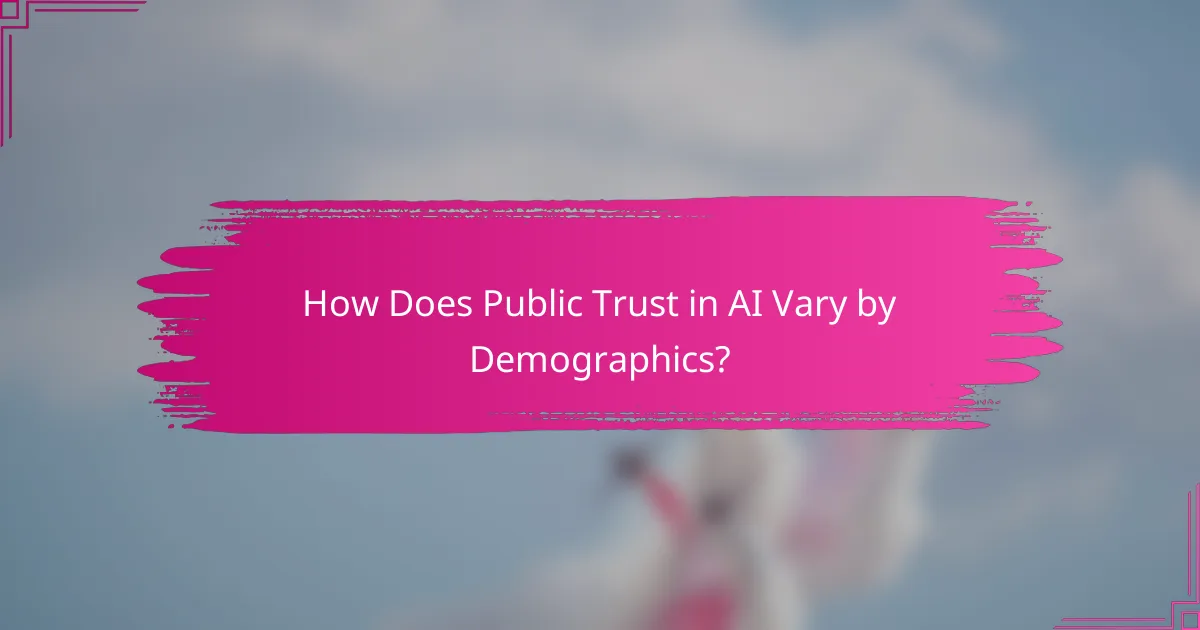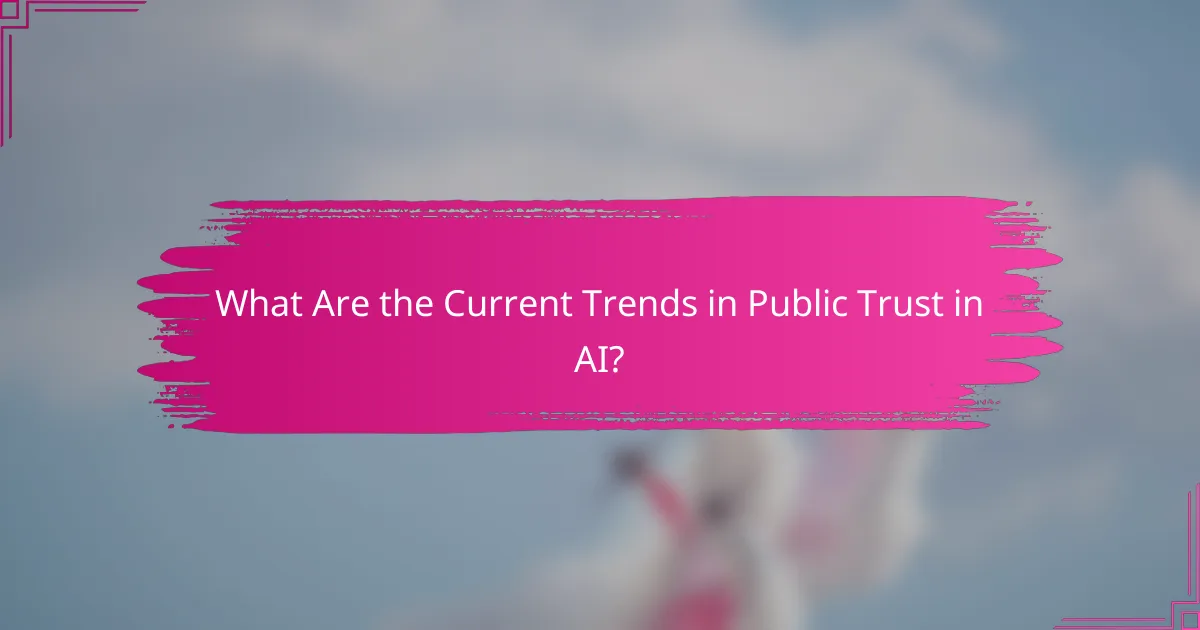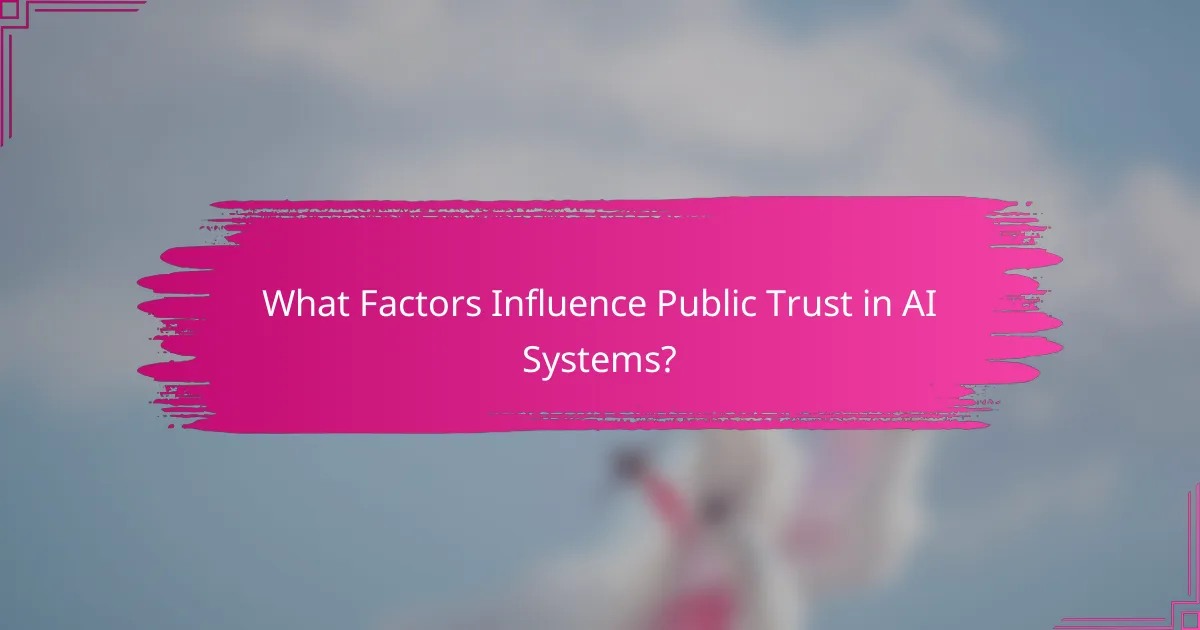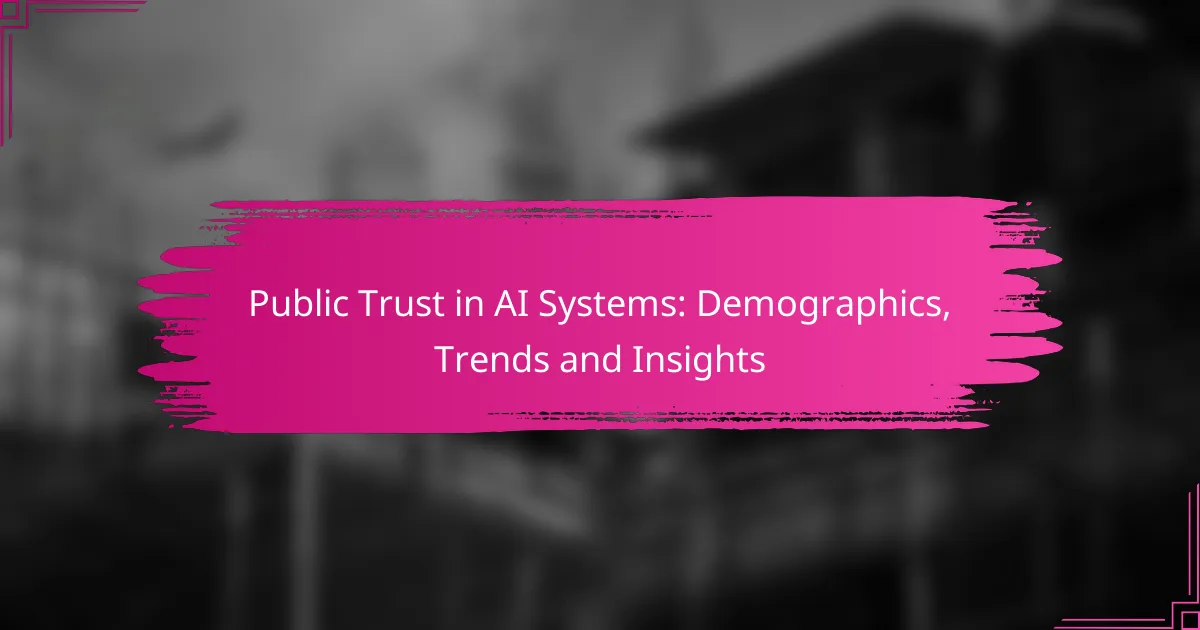Public trust in AI systems is a complex and evolving phenomenon, shaped by demographic factors such as age, gender, and education. As attitudes shift, organizations must recognize the varying levels of skepticism and acceptance among different groups, influenced by media narratives and specific incidents. By addressing key elements like transparency and data privacy, stakeholders can foster greater trust and ensure responsible AI implementation.

How Does Public Trust in AI Vary by Demographics?
Public trust in AI systems significantly varies across different demographic groups, influenced by factors such as age, gender, geographic location, education, and income. Understanding these variations can help organizations tailor their AI implementations and communication strategies to build greater trust among diverse populations.
Age group differences
Younger individuals typically exhibit higher levels of trust in AI compared to older generations. This trend may stem from younger people’s greater familiarity with technology and digital tools, leading to a more positive perception of AI’s capabilities.
For instance, surveys indicate that those aged 18-34 often view AI as a beneficial tool for enhancing daily life, while individuals over 55 may express skepticism regarding its reliability and ethical implications. Organizations should consider these age-related attitudes when designing AI systems and marketing strategies.
Gender disparities
Gender differences in trust towards AI are notable, with studies suggesting that men generally display more confidence in AI technologies than women. This disparity may be influenced by varying levels of exposure to technology and differing perceptions of risk associated with AI.
To bridge this gap, companies can engage in targeted outreach and education efforts aimed at women, highlighting the safety and benefits of AI systems. Creating inclusive environments that encourage women’s participation in technology development can also enhance overall trust.
Geographic variations
Trust in AI varies significantly by geographic region, often reflecting cultural attitudes towards technology. For example, countries with strong technological infrastructures, like the United States and South Korea, tend to show higher levels of trust compared to regions with less technological integration.
In Europe, regulatory frameworks such as the GDPR influence public perceptions of AI, as individuals may feel more secure knowing there are strict data protection laws in place. Understanding these geographic nuances is crucial for global AI deployment strategies.
Education level impact
Education plays a critical role in shaping trust in AI systems. Individuals with higher education levels often demonstrate greater trust, likely due to a better understanding of AI technologies and their potential benefits.
Conversely, those with lower educational attainment may harbor skepticism, fearing job displacement or misuse of AI. Educational initiatives that inform the public about AI’s workings and ethical considerations can help mitigate these concerns and foster trust.
Income level influence
Income level can also affect trust in AI, with wealthier individuals generally exhibiting more confidence in AI systems. Higher-income groups often have greater access to technology and are more likely to engage with AI applications in their daily lives.
In contrast, lower-income individuals may view AI as a threat to job security or as a tool that primarily benefits the affluent. Addressing these concerns through community engagement and demonstrating AI’s potential for improving quality of life can help build trust among economically disadvantaged groups.

What Are the Current Trends in Public Trust in AI?
Public trust in AI systems is evolving, with notable shifts in attitudes across different demographics. While some groups express increasing skepticism, others show growing acceptance, influenced by various factors such as media coverage and specific AI incidents.
Increasing skepticism
Many individuals are becoming more skeptical about AI technologies, driven by concerns over privacy, security, and ethical implications. This skepticism is particularly pronounced among older demographics and those with less technical knowledge, who may fear job displacement or misuse of personal data.
Surveys indicate that a significant portion of the population questions the transparency of AI decision-making processes. This lack of understanding can lead to distrust, as people feel uncertain about how AI systems operate and the potential biases they may harbor.
Growing acceptance
Conversely, younger generations and tech-savvy individuals are showing greater acceptance of AI, recognizing its potential to enhance efficiency and improve quality of life. Many see AI as a valuable tool in various sectors, including healthcare, finance, and education.
As AI applications become more integrated into daily life, acceptance is likely to increase. For instance, the use of virtual assistants and recommendation systems has generally been well-received, contributing to a more positive perception of AI technologies.
Impact of media coverage
Media coverage plays a crucial role in shaping public perceptions of AI. Positive stories highlighting successful AI implementations can foster trust, while negative reports about failures or ethical breaches can amplify skepticism. The framing of AI in news articles often influences how different demographics perceive its risks and benefits.
For example, sensationalized reporting on AI-related incidents can lead to heightened fears, particularly among those who are less informed about the technology. Balanced reporting that includes expert opinions and real-world applications can help mitigate these fears and promote a more nuanced understanding.
Influence of AI incidents
Specific incidents involving AI, such as data breaches or algorithmic biases, have a significant impact on public trust. High-profile cases can lead to widespread concern and calls for regulation, especially if they affect vulnerable populations or result in serious consequences.
To rebuild trust, organizations must address these incidents transparently and implement measures to prevent future occurrences. This includes adopting ethical guidelines and ensuring accountability in AI development and deployment, which can help reassure the public and restore confidence in AI systems.

You can explore further insights about this topic in public perception of AI.
What Factors Influence Public Trust in AI Systems?
Public trust in AI systems is influenced by several key factors, including transparency, data privacy, regulatory frameworks, and the perceived balance between benefits and risks. Understanding these elements can help organizations build more trustworthy AI applications.
Transparency and explainability
Transparency and explainability are crucial for fostering public trust in AI systems. When users understand how AI models make decisions, they are more likely to trust the outcomes. Clear communication about algorithms, data sources, and decision-making processes can enhance user confidence.
For example, an AI system used in healthcare should provide insights into how it diagnoses conditions. If patients can see the rationale behind a diagnosis, they may feel more secure in the treatment recommendations provided.
Data privacy concerns
Data privacy concerns significantly impact public trust in AI systems. Users are increasingly aware of how their personal data is collected, stored, and used. Organizations must prioritize data protection to alleviate fears of misuse or breaches.
Implementing strong data encryption, anonymization techniques, and clear privacy policies can help build trust. For instance, companies should inform users about what data is collected and how it will be used, ideally obtaining explicit consent before processing personal information.
Regulatory frameworks
Regulatory frameworks play a vital role in shaping public trust in AI systems. Well-defined regulations can establish standards for ethical AI use, ensuring accountability and fairness. Countries like the European Union are leading the way with comprehensive AI regulations that emphasize transparency and user rights.
Organizations should stay informed about local regulations and ensure compliance. This may involve regular audits of AI systems and adapting practices to meet evolving legal standards, thus reinforcing public confidence in their technologies.
Perceived benefits vs. risks
The balance between perceived benefits and risks influences public trust in AI systems. Users tend to trust AI more when they see clear advantages, such as improved efficiency or enhanced decision-making. However, if the risks, such as job displacement or biased outcomes, are perceived as high, trust diminishes.
To foster trust, organizations should communicate the benefits of their AI systems while addressing potential risks transparently. Providing case studies that highlight successful AI implementations can help demonstrate value while reassuring users about safety and fairness.

How Can Organizations Build Trust in AI?
Organizations can build trust in AI by prioritizing transparency, ethical practices, and user engagement. Establishing clear guidelines and fostering an informed user base are essential steps in creating a reliable relationship between AI systems and their users.
Implementing ethical guidelines
Implementing ethical guidelines involves creating a framework that governs AI development and deployment. Organizations should adhere to principles such as fairness, accountability, and transparency to ensure that AI systems operate without bias and respect user rights.
To effectively implement these guidelines, organizations can conduct regular audits of their AI systems and engage with diverse stakeholders for feedback. This approach helps identify potential ethical concerns and fosters a culture of responsibility.
Enhancing user education
Enhancing user education is crucial for building trust in AI systems. Organizations should provide clear information about how AI works, its benefits, and potential risks. This can be achieved through workshops, online resources, and user-friendly documentation.
Additionally, organizations can develop training programs that empower users to understand AI functionalities and make informed decisions. Providing real-world examples and case studies can further demystify AI technology and promote confidence among users.
